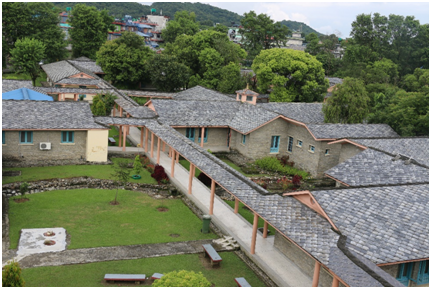HEH Introduction
Himalaya Eye Hospital (HEH) was inaugurated on March 1st 1993 by the late King Birendra Bir Bikram Shah. The conception of building an eye hospital in Pokhara, Nepal happened sometime after few eye care outreaches were conducted in remote areas of Karnali, Gandaki and Dhaulagiri zones of Nepal. A team of volunteer doctors from the Netherlands would visit remote parts of these 3 zones and provide free eye care services. These outreaches (often called eye camps) were supported through various charitable programmes organized in the name of Oogkamp Himalaya.
The Dutch Ophthalmologist Dr. Gerard Smith with filmmaker Bas Anselms and photographer Hans Donkersgoed first visited Nepal for eye camp expedition in 1984. The success of the very first eye camp provided evidence for repeat missions. Although these camps were blessings to people seeking eye services, the process wasn’t sustainable. Meanwhile, Peter de Boer initiated fundraising for these eye camps through Libelle magazine. Later in 1985 the Foundation Oogkamp Himalaya was registered and same year they won the “Libelle Puzzle Marathon”, an award worth one million Guilders. With an increased funding, building an infrastructure in name of Himalaya Eye Hospital meant provision of eye care services through development of local leadership was possible.
By 1978 a local Non-Governmental Organization (NGO) Nepal Netra Jyoti Sangh (NNJS) had established with the aim of providing sustainable eye care in country. Following up on the conceptualization of establishing HEH, the Netherlands based organization Eye Care Himalaya Foundation (previously known as Oogkamp Himalaya Foundation) partnered with NNJS and established HEH in Pokhara.
Australian architect and artist Robert Powell was the mastermind to design the HEH building. He was very successful in his intention to align the design of the hospital building with local architecture such that it would not be intimidating for the patients from the mountainous region. In the initial stages of construction of the HEH, one of the challenges was to have local acceptance ofthe hospital and its social, economic and environmental impact. For that instead of using heavy machinery equipment to clear the rocks from the terrain and to build the hospital, they employed local people and used local skills and manpower which was already more accepted in the community. Till date the construction and design of HEH complex is unique and has traditional Nepali flavor. In the earlier years HEH was quite far away from the main Pokhara city.Commuting to and from the eye hospital was cumbersome. With the ongoing development and crowding the eye hospital now lies within Pokhara city and resembles a park of traditional Nepali building with slate roof surrounded by concrete buildings from all sides.

A problem at HEH from the time it was built was the water management. During heavy rainfall, the whole terrain would be flooded having no way to flow out. With urbanization and roadways built all over the water problem has only increased. Dutch landscape architect Pieter Germeraad came to solve this problem with a retention pond, so that there would be water available to irrigate the plants even during the driest months.
In the early years of operation HEH was financially supported by Foundation Eye Care (now called Eye Care Foundation) and its Nepal programme was led by Deepak Lama. HEH first operated with 39 clinical and non-clinical staff led by a Dutch Ophthalmologist Dr. Wouter Japing, the first Medical Director of HEH. For past twenty-eight years HEH has seen many progressive changes and other than the first 5 years it has been led by local Ophthalmologists.
HEH Vision:HEH follows the vision of its parent organization, Nepal Netra Jyoti Sangh (NNJS), “Nepal where no one is blind due to avoidable causes and everyone has access to comprehensive and equitable eye care services in the country”. Based on this vision we work in the Gandaki and the Karnali region.
HEH Mission:
- To develop and provide high quality, sustainable, comprehensive and affordable eye care services to people residing in Gandaki and Karnali region
- Reduce avoidable and preventable visual impairment and blindness in the region thereby help in elimination of avoidable blindness from the country.
- Network in the country by identifying and mobilizing local, national and international resources,
- To attain multi-sectoral partnership in order to expand access to eye care services
- To conduct and develop basic and clinical research into eye diseases
- Human resource development in eye care
- Product development in order to provide eye care services to all segments of population without any discrimination by maintaining equity, efficiency and excellence
HEH is a tertiary eye hospital in Gandaki Province of Nepal.HEH was established with the vision to provide eye care services to people in Gandaki, Dhaulagiri and Karnali zones (presently Gandaki and Karnali Provinces).HEH is serving nation through various models of eye health services for past three decades. Currently, HEH provides eye care services through the main hospital located at Gharipatan, Pokhara and the other twenty two district and primary eye care centres (DEC / PEC) located in different districts. In its base hospital HEH provides therapeutic eye care and vision care services to the people from different parts of the country. Often HEH conducts screening and surgical camps to various remote locations of the country.
